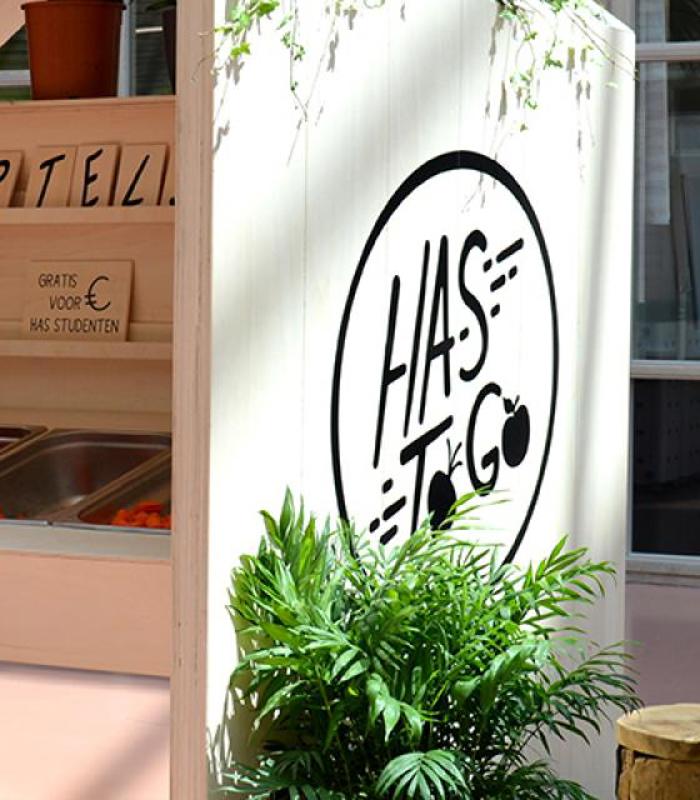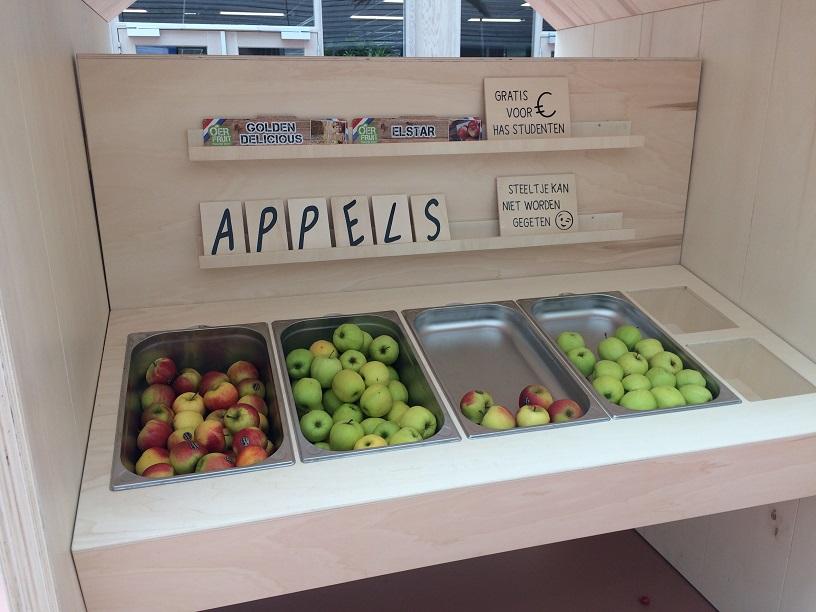Imagine: you’re 18 years old and studying at HAS University of Applied Sciences. You’re enjoying student life and you’re not that bothered about how much fruit and veg you’re eating. You wouldn’t mind eating a few more carrots, tomatoes, apples and bananas, but you don’t really want to go to too much trouble to do so. One day, you arrive at uni and see a small wooden hut out of the corner of your eye, with ‘HAS To-Go’ on it. You have to pass by that way anyway, so you decide to have a look. In the hut, there are snack cucumbers, cherry tomatoes and shiny red apples. The look good. It doesn’t take you long to decide to pick up an apple, and why not take a few cucumbers as well, while you’re there. And then you head to your next class.
Low fruit and veg intake
Things aren’t looking good when it comes to fruit and veg intake among young people. According to Dutch consumer research carried out between 2007 and 2010, fewer than 7% of young people between 14 and 30 years, achieve the recommended daily intake of fruit and veg. In research carried out by VU University Amsterdam, fewer than 10% of university students achieved the daily recommended intake of veg. This provided enough evidence that things needed to change. But, unfortunately, students are a forgotten group when it comes to improving eating habits. Many of the new initiatives aimed at getting people to eat more fruit and veg are not aimed at students. They target school children or young families, for example, but the lives of these groups are very different than those led by students.
How do you get students to eat more fruit and veg?
Students are destined to become the driving force of society. So, that’s why Herman Peppelenbos, holder of the HAS chair in Green Health, started a collaboration with the VU. Together, the partners wanted to gain insight into how you can get students to eat more fruit and veg. Two Food Innovation students, Ella Roelfsema and Noortje van Dijk, picked up this issue for their graduation project.
As long as it’s not too much hassle
In general, students are quite prepared to eat more fruit and veg, as long as it’s not too much hassle. Ella and Noortje started by taking a baseline measurement among 400 HAS students, and discovered that the fruit and veg intake at HAS is slightly higher than in other surveys: around 20% of HAS students eat enough veg en fruit. “This is probably due to the fact that we offer food-related study programmes,” says HAS University of Applied Sciences project leader, Roos Leufkens. “So, our students are slightly more aware than other students of the fact that they should eat enough fruit and veg. But this percentage is, of course, still very low.” The majority of students indicated that they wouldn’t mind eating more fruit and veg, but it really did need to be easy to do so.
Snack veg are a real hit
The benchmark results led to research being carried out into how to make access to fruit and veg as easy as possible for students in their study environment. The solution: the ‘HAS To-Go’ hut. During 2, 2-week periods, Noortje and Ella offered fellow students a variety of snack fruit and veg from the ‘HAS To-Go’ hut. They observed how students reacted to this concept, and repeated the measurement of the intake levels of fruit and veg among students, to see if anything had changed in their behaviour. They also asked students what they thought of the initiative. Here are just some of the reactions: “Nice hut with fresh veg, great initiative.” “We can always grab something when we have a break.” “Good initiative because it makes students aware of the fact that they need to eat healthy food.” At the end of the project, it appeared that the students’ fruit and veg intake had gone up compared to the baseline. Roos: “The snack veg, in particular, did really well and it’s clear that this has great potential. So, the hut is a good way to get students to eat more veg at other times than just during meals.”
To be continued: PhD
Despite the fact that Noortje and Ella have now completed their final year project, Roos has said that it will be continued. Although it’s not quite clear how. “We’d like to repeat the research at other academic institutions, to see if the hut also contributes to students eating more fruit and veg there. I also hope that the ‘HAS To-Go’ hut is given a permanent spot at HAS.” Roos is really proud of the suppliers of the fruit and veg for the research. “They all reacted positively to our research, and most of them offered their products for free.” Researchers, Coosje Dijkstra and Nicole van den Bogerd from the VU will analyse all the details from the experiment, as part of Nicole’s PhD.


